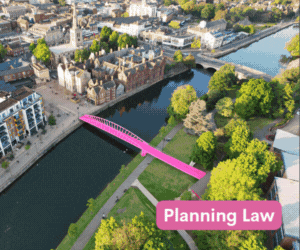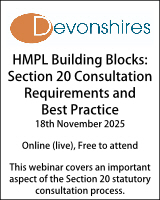Negotiating s106 agreements
Why does negotiating section 106 agreements have to be such a drag? Simon Ricketts looks at the key issues.
- Details
The Home Builders Federation’s (HBF’s) May 2025 research piece What is the timeframe for local authorities to agree community investment? shows what a huge drag on planning permission timescales is represented by the process of negotiating a section 106 agreement (which of course needs to have been completed before planning permission can be issued).
Read this:
“To better understand the current state of S106 agreement timelines, the Home Builders Federation (HBF) submitted a Freedom of Information (FOI) request to local planning authorities across England. These results are based on the data from more than 2,500 S106 agreements across over 50 local authorities.
The FOI exercise found that the average S106 approval timeline was:
2022/23: 425 days
2023/24: 459 days
2024/25: 515 days
In just two years, the average time required to finalise an S106 agreement has increased by 90 days – a 20% increase.
The responses also highlight the extremities that developers in some local authorities are facing. The maximum recorded timescale was 2,679 days, or more than seven years, for a single S106 agreement to complete the agreement process. The shortest average timescale reported by any of the respondent councils was 192 days.
Additionally, 35% of all S106 agreements took longer than 12 months to finalise. Across all responses, 76% of local authorities reported average timelines that exceeded a year, and over a third of councils had an average timeframe of over 500 days.
In 2024/25, 45% of LPAs had agreements finalised that had taken over 1,000 days to complete.”
The document doesn’t specify the scale threshold of applications considered (I’m assuming by the number of agreements that this is in relation to developments of any scale, not just complex schemes where we know that specific issues requiring bespoke solutions and substantive negotiations may required to unlock solutions). Nor does the document specify when these time periods are measured from: validation of the application, instruction of the LPA’s solicitor or the resolution to grant. Whatever, the statistics are appalling as is the relentlessly worsening trend.
The work is of a piece with the equally depressing Richborough/LPDF research carried out by Lichfields, How long is a piece of string? (16 May 2025). The average determination period for outline planning applications for 10 dwellings or more was 284 days in 2014. In 2024 it was 783 days. Given improvements in the performance of the Planning Inspectorate in relation to planning appeals (particularly appeals determined by way of public inquiry), it is now substantially quicker to secure a decision by way of appeal than by waiting for a final decision from the local planning authority.

This reflects our own anecdotal experience; we are seeing far more appeals on the basis of non-determination within the statutory period, and (tying back into that HBF work) one factor for clients is that with an appeal there is an external discipline upon the parties to agree and complete the section 106 agreement or unilateral undertaking within a specific, externally set, timescale.
Stepping back, this is all crazy and contrary to the efficient operation of the public sector. It’s equivalent to the use of A&E departments by those who find it faster, easier or more effective than going to their GP. Something is massively wrong with the operation of the planning system and it’s nothing that the Planning and Infrastructure Bill or indeed in the government’s December 2024 changes to the NPPF will fix. MHCLG’s proposed alterations to the system in relation to “minor” and “medium” residential development (summarised in my 31 May 2025 blog post Small Changes). Indeed I referenced in that post what was said in relation to section 106 agreements for “medium” residential development (less than 50 dwellings – although why stop at that size cap?):
“We … welcome views and evidence on:
1. the specific barriers facing SMEs in agreeing s.106 obligations – including availability of willing and suitable Registered Providers
2. what role national government should play in improving the process – including the merits of a standardised s.106 template for medium sites
3. how the rules relating to suitable off-site provision and/or appropriate financial payment on sites below the medium site threshold might be reformed to more effectively support affordable housing delivery, where there is sufficient evidence that onsite delivery will not take place within a suitable timeframe and noting the government’s views that commuted sums should be a last resort given they push affordable housing delivery timescales into the future.”
The lack of a standardised template is one issue. We end up having frustrating arguments over what should be uncontentious and standard wording, for instance to protect mortgagees in a way which is institutionally acceptable, or simply over our attempts to make a particular LPA’s “standard” drafting operate as the parties intend. The failure of the Law Society to update its June 2010 template (which never really achieved sufficient support and was not well used) is disappointing. Without drama we need a national template on the MHCLG website asap for smaller schemes, expressly supported by local government, the development industry and professional bodies (including those representing banks), with specific guidance as to the circumstances in which there can be departures.
But the problems go much wider than that:
Many LPA legal teams are woefully under-resourced, without a lawyer with the necessary experience, project management focus or internal clout to do more than act as a post-box with those instructing them, adding pressure and unfair responsibility on planning case officers or allowing other internal or external consultees to drive their particular agendas. There is often a reluctance on the part of the in-house legal team to outsource to an external law firm (even though the applicant pays and is usually eager to pay more if that results in faster delivery of the completed agreement) because of internal pressures not to de-skill further the in-house team or lose the ability to recoup costs.
I suspect that LPA lawyers (some of whom are true unsung heroes) would equally point the finger at some applicants’ solicitors – and indeed some applicants – who may be unprepared to back down from unreasonable negotiating positions or may introduce new points post committee resolution – or who may start ghosting them when something commercially is happening in the background.
Negotiations often start way too late. The government’s planning practice guidance on planning obligations (1 September 2019) says this:
“When should discussions on planning obligations take place?
Discussions about planning obligations should take place as early as possible in the planning process. Plans should set out policies for the contributions expected from development to enable fair and open testing of the policies at examination. Local communities, landowners, developers, local (and national where appropriate) infrastructure and affordable housing providers and operators should be involved in the setting of policies for the contributions expected from development. Pre-application discussions can prevent delays in finalising those planning applications which are granted subject to the completion of planning obligation agreements.”
So often though, this isn’t happening.
There also no easy answer if negotiations genuinely hit a brick wall – for instance as to whether a particular contribution is justified or as to the precise drafting of a particular clause. Section 158 of Housing and Planning Act 2016 specifically inserted section 106ZA and Schedule 9A (“resolution of disputes about planning obligations”) into the 1990 Act, to provide for a system where an independent expert could be called upon where there are sticking points in section 106 negotiations, but it was never brought into force. It’s sitting there just waiting to be fleshed out by an SI and switched on! Whether the third party were to make a binding determination or, more practically, gave non-binding guidance that would still carry some weight if an appeal were subsequently required, in my view this needs to be dusted off!
Section 106 agreements are also of course lumbering beasts of burden, the legal mechanism for delivering so many strands of public policy – affordable housing, affordable workspace, carbon reduction measures, social infrastructure (eg education, health), transport infrastructure, local employment and training, affordable workspace, air quality, the complexities of viability review processes. What can we deal with by way of other mechanisms (eg conditions), or standardise? What should be left to other legislation? The financial weight of the obligations in a section 106 agreement in relation to any large scheme is huge – in some ways, it is no surprise that the agreement may take as long or longer to negotiate than it took for the application to get from validation to committee resolution, but what can we simplify, speed up, twin-track?
The Planning Inspectorate also has its PPlanning obligations: good practice advice (updated 5 February 2025), which is more specific than the government’s planning practice guidance and has its more prescriptive timing requirements (completed planning obligation at the time the written representations appeal is lodged is a tough one…). This is the sort of thing (with suitable adjustments) we need for the application stage, with real consequences for those who do not follow it.
Going back to the HBF work, several suggestions for improvements were made, various of them overlapping with what I have been saying:
- “Increase resourcing for planning departments: Local planning authorities are currently under significant resource constraints, which affect their capacity to process planning obligations in a timely manner. To alleviate these challenges, government should allocate targeted funding to increase staffing levels within planning departments. By investing in dedicated S106 teams and offering professional development opportunities, councils can improve both the speed and quality of agreement processes.
- Develop national standard templates and best practices: A lack of standardisation in the drafting of S106 agreements often leads to protracted negotiations and inconsistencies across councils. The government, in collaboration with planning authorities and the development sector, should produce standardised procedural guidelines and clauses to minimise the need to draft agreements from scratch. In lieu of official standardisation, there could be clearer guidance and expectations on good practice.
- Encourage a more flexible use of cascade agreements where necessary to ensure homes can be built and give reassurance to the developer that if an RP cannot be found, that the Affordable Homes can be changed to an alternative tenure or as last resort, a payment made to the LPA in lieu of the Affordable Housing.
- Introduce statutory timelines for S106 agreements: Consideration should be given to implementing statutory or guideline-based timescales into the application and pre-application process for handling Section 106 negotiations and the drafting and signing of agreements.
- Monitor, benchmark, and report performance: Introducing monitoring and reporting of S106 performance metrics could drive improvements. Local authorities should publish data on average timescales, agreement outcomes, and compliance rates as part of the general reporting on S106 agreements through Infrastructure Funding Statements. This information could be used to benchmark performance across regions, highlight best practices, and identify areas needing intervention. Increased transparency can also build trust among stakeholders and help developers better plan and budget projects.”
I’m sure this can be cracked, easily. Look what Bridget Rosewell’s recommendations on the planning appeal process achieved. If in a couple of years colleagues are still spending much of their time chasing for progress on draft agreements and having to explain to frustrated clients why there is no progress, I’ll be pointing you back to this blog post.
I know most of us have all grown up with this section 106 run-around – indeed some of us are in fact part of Generation Section 52 – hard-copy travelling drafts sent by post, marked up in a sequential series of colours, by pen – yes it was, despite all that, a faster process than present – but, in the words of the Blow Monkeys from that period: it doesn’t have to be this way.
Simon Ricketts is a partner at Town Legal. This article first appeared on his Simonicity planning law blog.
Contracts & Procurement Lawyer
Lawyer - Property
Trust Solicitor (Employment & Contract Law)
Senior Lawyer - Contracts & Commercial
Locums
Poll









































